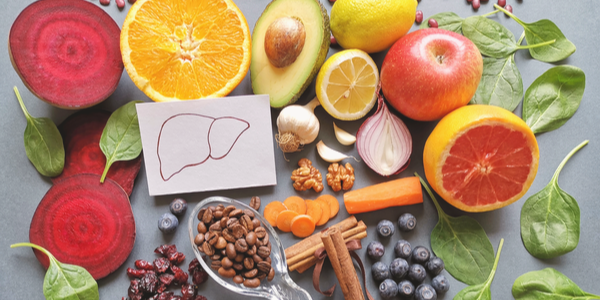
The body can store undesirable amounts of fat but did you know organs can store fat, too? Known as visceral fat when it surrounds organs, this kind of fat is more harmful to health than the subcutaneous kind typically held around the stomach, thighs, and arms. Fatty liver disease is a prime example of visceral fat accumulation and an increasingly growing problem.
What causes fatty liver and what can you do about it? Learn about potential complications and the best diet for a fatty liver here.
The Liver
The second largest organ in the body, the liver is located in the upper right portion of the abdominal cavity beneath the diaphragm and atop the stomach. It consists of two main lobes that connect to ducts to form the common hepatic duct. This duct transports bile to the gallbladder and upper part of the small intestine via the common bile duct.
The liver exerts numerous vital functions and some of the most important include:
• Production of bile for proper absorption of fats
• Production of protein
• Production of cholesterol and hormones
• Regulation of blood sugar and amino acid metabolism
• Processing of hemoglobin
• Conversion of ammonia to urea
• Detoxification of harmful substances and drugs
• Regulation of blood clotting
• Creation of immune factors
• Removal of bacteria and other pathogens from the blood
• Clearance of bilirubin
If we know that general fat accumulation poses health risks, imagine the dysfunction that can occur when fat accumulates around this previous organ.
What Is Fatty Liver Disease?
Fatty liver disease, sometimes called hepatic steatosis, is a common condition caused by the storage of fat in the liver. It becomes a problem when fat reaches about 5-10% of the liver's weight. The condition can progress through three stages:
1. Steatohepatitis - the liver becomes swollen and tissue is damaged. On routine blood work, liver enzymes ALT, AST, and/or alkaline phosphatase may be elevated.
2. Fibrosis - scar tissue forms where the liver is damaged. Liver enzymes are almost always elevated at this point and symptoms are usually evident.
3. Cirrhosis - extensive scar tissue replaces healthy tissue. This is typically considered liver failure and the prognosis is not great.
There are actually two types of fatty liver disease, including nonalcoholic fatty liver disease and alcoholic fatty liver disease (AFLD).
Nonalcoholic Fatty Liver Disease (NAFLD)
NAFLD refers to fat build-up in the liver in those who do not drink much, if any, alcohol. If there is excess fat along with inflammation in the liver, it’s sometimes diagnosed as nonalcoholic steatohepatitis (NASH).
If left untreated, it can progress to fibrosis and eventual liver failure otherwise called cirrhosis.
Alcoholic Fatty Liver Disease (AFLD)
AFLD is fatty liver disease directly related to high alcohol consumption. High amounts of fat accompanied by liver inflammation is similarly called alcoholic steatohepatitis (ASH). AFLD commonly leads to fibrosis and resulting cirrhosis.
Unfortunately, symptoms of fatty liver are not always obvious until it progresses to the later stages. Regardless of the kind, some common symptoms of fatty liver and more appropriately, cirrhosis, include:
• Abdominal pain in the upper right side of the belly
• Nausea, loss of appetite, or weight loss
• Yellowing skin and/or whites of the eyes (jaundice)
• Swollen abdomen (ascites)
• Swelling of the legs (edema)
• Itchy skin
• Easy bruising or bleeding
• Dark urine
• Pale stools
• Web clusters of blood vessels under the skin
• Breast enlargement in men
• Extreme fatigue and/or weakness
• Mental confusion
How Does Fatty Liver Develop?
Alcohol, toxins, other drugs (even OTC ones), poor quality diets, and generally harmful substances can alter liver metabolism in a negative way. One of the most common dysfunctions is popularly known as insulin resistance.
Fatty liver starts to occur when adipocytes or fat cells release inflammatory fat particles into the bloodstream. The liver scoops up the extra circulating fat and stores it, causing fat deposits to collect within and around liver cells.
When this happens, the mitochondria powerhouses of cells that use oxygen to create usable energy get burdened by extra fat and reduce function. This increases free radical production leading to inflammation, cell damage, and liver tissue scarring.
When liver tissue is harmed or dies, it releases enzymes into the blood the same way a heart does after it suffers a heart attack. Typically, doctors order the blood tests ALT, AST, and alkaline phosphatase to determine the extent of liver damage. Occasionally, an ultrasound or liver biopsy is also performed.
Specific factors that increase the risk for fatty liver disease are:
1. Obesity and metabolic syndrome
2. Insulin resistance and type 2 diabetes
3. High consumption of refined sugar, especially high fructose corn syrup
4. Excess intake of poor quality carbohydrates
5. High intake of poor quality saturated fats and trans fat
6. Moderate to high alcohol intake
7. Low intake of fruits and veggies
8. Sedentary lifestyles
9. Infections like hepatitis C
10. Smoking
11. PCOS
12. Rapid weight loss
13. Exposure to certain toxins
14. Certain medications (methotrexate, tamoxifen, amiodarone)
15. Rare genetic conditions
Preventing and Treating Fatty Liver Disease
Prevention and treatment of fatty liver disease are quite similar. Furthermore, the liver is stellar at regenerating itself, deeming early to middle stages of fatty liver disease as reversible!
1. Consume a nutrient-dense diet.
Because insulin resistance and metabolic dysfunction drive fatty liver disease, diet is the single best tool to prevent or treat this condition.
Fruits and vegetables contain antioxidants that reduce inflammation and bolster metabolic function. High-quality proteins supply amino acids that the liver builds into beneficial protein while healthy fats help the liver produce enough bile.
It is equally as important to reduce inflammatory processed and packaged foods, refined and added sugars, sugary beverages, trans fat, and poor quality saturated fat in conventionally raised animals.
Some of the best liver-supporting foods are:
• Leafy greens
• Almonds
• Eggs
• Organ meats
• Carrots
• Jerusalem artichokes
• Fennel seed
• Seafood
• Dark chocolate
• Kidney beans
• Raw broccoli sprouts
2. Consistently exercise enough.
Diet's favorite companion is exercise. When practiced healthfully together, they can lead to weight loss that is very protective to the liver. In fact, losing just 7% body weight is known to reverse fatty liver disease in many people.
Include strength training and some cardio for 45 minutes to an hour a day three to five times a week to reap the most benefits. Research shows that doing this can reverse fatty liver within eight weeks.
3. Support the liver in other ways.
Diet and exercise are the biggest pieces to the puzzle. However, plenty of other lifestyle habits can generally improve liver function and reduce the risk of fatty liver disease such as:
1. Reduce prescription and OTC medications and synthetic supplements
2. Drink plenty of mineral-rich water
3. Practice lymphatic drainage techniques like dry brushing
4. Take cold showers
5. Reduce conventional beauty and household cleaning products
6. Get 10-15 min of sunlight without sunscreen right in the morning
7. Stop smoking and reduce second-hand smoke
8. Avoid drugs
9. Add cilantro, parsley, and turmeric to cooking
10. Support through herbs: milk thistle, marshmallow root, licorice root, dandelion root
11. Balance hormones
12. Reduce and manage stress effectively
The Bottom Line
The liver is a magnificent organ that exerts many vital functions within the body. Any dysfunction of the liver can wreak havoc on systemic health. One major liver condition is fatty liver disease, caused by excessive alcohol or generally poor lifestyle choices.
Of everything, obesity and insulin resistance affect the development of fatty liver disease most. Moderating alcohol consumption, consuming a nutrient-dense diet, exercising enough, and supporting the liver in other ways can prevent and/or reverse this condition successfully.
References:
Fatty Liver Disease: Risk Factors, Symptoms, Types & Prevention. Cleveland Clinic. https://my.clevelandclinic.org/health/diseases/15831-fatty-liver-disease.
Liver: Anatomy and Functions. Johns Hopkins Medicine. https://www.hopkinsmedicine.org/health/conditions-and-diseases/liver-anatomy-and-functions.
Seladi-Schulman J. Everything You Need to Know about Fatty Liver. Healthline. Updated November 11, 2021. https://www.healthline.com/health/fatty-liver#diagnosis.







